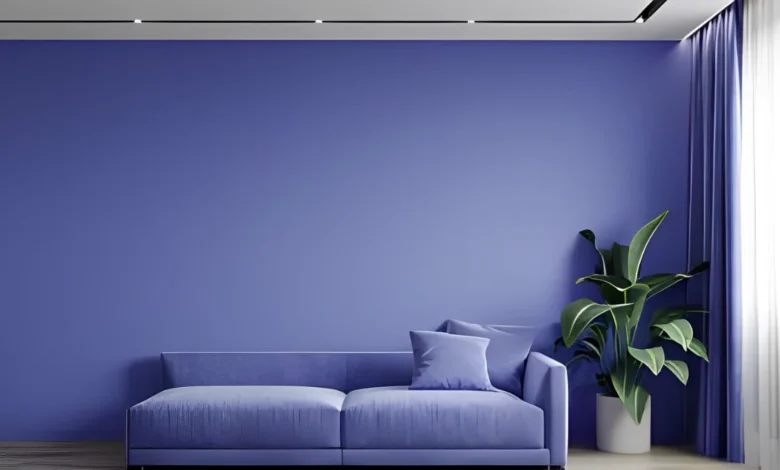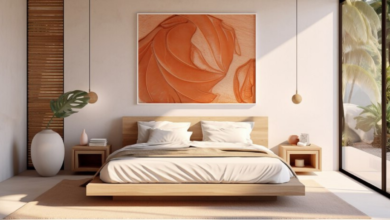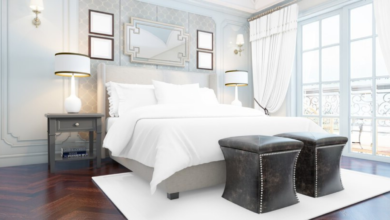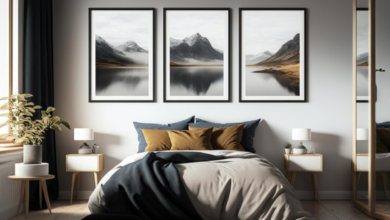Revamp Your Space: Inspiring Room Painting Designs and Ideas

Introduction to Room Painting Designs
Room painting is more than just adding a fresh coat of paint to your walls. It is a transformative process that can completely change the look and feel of a space. In this blog post, we will explore the importance of room painting, the benefits it brings to your space, and the factors to consider before getting started.
The Importance of Room Painting
A. Aesthetics: The color of your walls sets the overall tone of a room. It can create a calming atmosphere in the bedroom or a vibrant and energetic space in the living room. Choosing the right paint colors can enhance the beauty of your home and reflect your personal style.
B. Mood Enhancement: Colors have a significant impact on our mood and emotions. By selecting appropriate paint colors, you can create a space that promotes relaxation, productivity, or creativity, depending on your needs.
Personalization: Room painting allows you to express your individuality and tailor your space to your preferences. It is an opportunity to infuse your personality into your surroundings and make your space truly your own.
Benefits of Revamping Your Space with Paint
A. Cost-Effective: Revamping your space with paint is a budget-friendly way to transform your home. Compared to other renovation projects, painting is relatively inexpensive and yields impressive results.
B. Versatility: With the wide variety of paint colors and finishes available, you can achieve endless design possibilities. Whether you prefer a classic and elegant look or a bold and modern aesthetic, paint can help you achieve your desired style.
C. Easy Upkeep: Painted walls are easier to clean and maintain compared to other wall coverings. With regular cleaning and occasional touch-ups, your freshly painted walls can continue to look pristine for years.
Choosing the Right Colors
When it comes to room painting, the choice of colors is crucial. Different colors evoke different emotions and have a significant impact on the overall ambiance of a room.
Understanding the Psychology of Colors
- Calming Colors for Relaxation: Soft blues, pale greens, and lavender are known to promote relaxation and tranquility in spaces like bedrooms and bathrooms.
- Energizing Colors for Productivity: Bright yellows, vibrant oranges, and energetic reds can invigorate spaces such as home offices and workout areas, boosting productivity and motivation.
- Bold Colors for Creativity: Pantone’s Color of the Year, deep purples, fiery reds, and rich blues can inspire creativity and make a statement in areas like art studios and creative spaces.
Harmonizing Colors for a Cohesive Look
To achieve a cohesive and visually pleasing look, consider the following color schemes:
- Complementary Color Schemes: Colors that are opposite each other on the color wheel, such as blue and orange or red and green, create a striking contrast that adds visual interest.
- Analogous Color Schemes: Harmonious colors that are adjacent to each other on the color wheel, such as shades of green and blue or purple and pink, create a soothing and unified look.
- Monochromatic Color Schemes: Different shades and tints of a single color, such as various shades of blue or gray, can create a sophisticated and elegant look.
Unique Color Combinations to Make a Statement
For those who love to experiment, consider these unique color combinations:
- Unexpected Pairings for a Modern Twist: Mix bold colors like teal and lime green or coral and navy blue for a modern and eclectic look.
- Warm and Cool Contrasts for Balance: Combine warm tones like mustard yellow and cool tones like sky blue to create a visually balanced and inviting space.
- Neutral Colors with a Pop of Vibrancy: Paint the majority of your walls with calming neutrals like beige or gray and add a vibrant accent with a pop of color, such as a bright red door or a feature wall in vibrant yellow.
Accent Wall Ideas
Creating an accent wall is an excellent way to add visual interest and enhance the overall design of a room. Here are some ideas for creating impactful accent walls.
Creating Focal Points with Accent Walls
- Strategic Placement for Visual Impact: Choose a wall that draws attention, such as the one behind a bed, fireplace, or sofa. This ensures your accent wall becomes the centerpiece of the room.
- Using Patterns to Enhance the Space: Opt for patterns like stripes, chevrons, or geometric shapes to create a dynamic and eye-catching accent wall.
- Incorporating texture for depth: Consider textured wallpaper, stucco finishes, or faux brick panels to add depth and tactile interest to your accent wall.
Accent Wall Color Choices
- Bold and Dramatic Hues: Go for attention-grabbing colors like deep burgundy, navy blue, or emerald green to create a striking accent wall.
- Subtle Tones for Elegance: Choose soft and understated colors like pastel pink or pale gray for a more refined and elegant vibe.
- Metallic Finishes for Glamour: Add a touch of glamour with metallic finishes like gold, silver, or bronze. Metallic accent walls can instantly elevate the look of any room.
Accent Wall Designs for Different Rooms
- Statement Wall in the Living Room: Create a statement wall behind your TV or fireplace with bold colors or captivating patterns to make your living room truly stand out.
- Serene Accent in the Bedroom: Opt for muted and calming colors like pale blue or soft lavender to create a relaxing and peaceful atmosphere in your bedroom.
- Creative Display in the Home Office: Design an accent wall that showcases your creativity and inspires productivity. Consider using bold and energizing colors or motivational quotes as a backdrop for your workspace.
Wall painting techniques
Beyond selecting the right colors, various wall painting techniques can add texture, depth, and visual interest to your space.
Texture Painting for Added Dimension
- Sponging Technique for a Mottled Effect: Use a natural sponge to create a unique and textured look on your walls. By dabbing or dragging the sponge lightly, you can achieve a mottled effect that adds depth and visual interest.
- Rag Rolling for a Subtle Texture: This technique involves rolling a bunched-up rag over wet paint to create a soft and subtle texture that mimics the look of fabric or aged plaster.
- Stenciling for intricate patterns: Stencils offer endless possibilities for creating intricate patterns on your walls. From floral motifs to geometric shapes, stenciling can add a personalized touch to any space.
Ombre Walls for a Gradient Effect
- Choosing Colors for a Smooth Transition: Select two or more shades of the same color, with one being darker than the others. From light to dark, these colors will gradually blend into each other, creating a beautiful ombre effect.
- Creating the Ombre Effect with a Paintbrush or Roller: Start with the lightest color at the top of the wall and gradually layer the darker shades below. Blend the colors together using a paintbrush or a roller to achieve a seamless gradient effect.
- Blending Tips for a Professional Finish: Keep a wet edge as you work, blending the colors while the paint is still wet. This ensures a smooth transition from one color to the next.
Geometric Wall Patterns
- Tape Designs for Clean Lines: Use painter’s tape to create crisp and clean geometric patterns on your walls. Whether it’s a chevron, herringbone, or even a geometric mural, this technique adds a contemporary touch to your space.
- Triangles, Diamonds, and Hexagons for Modern Appeal: Experiment with different geometric shapes to create eye-catching wall patterns. Triangles, diamonds, and hexagons can be arranged in various configurations to achieve a modern and sophisticated look.
- Alternating Colors for Dynamic Patterns: Paint alternating sections of your wall in different colors to create a dynamic and geometric pattern. This technique adds visual interest and can make a small room appear larger.
Wall Murals and Artistic Designs
For those looking to make a bold statement, wall murals and artistic designs are an excellent choice. They can elevate your room’s aesthetic and create a unique focal point.
Custom Wall Murals for Personalization
- Collaborating with artists or designers: Work with a professional artist or designer to create a custom wall mural that reflects your personality and complements the overall aesthetic of your space.
- Nature-Inspired Murals for Tranquility: Bring the beauty of nature indoors by opting for murals depicting serene landscapes, lush forests, or calming seascapes. This creates a tranquil and refreshing ambiance.
- Abstract Murals for Contemporary Spaces: Abstract murals can add a contemporary and artistic touch to any room. Consider bold brushstrokes, vibrant colors, or geometric patterns to create a visually striking statement.
Trompe-l’oeil Techniques for Illusion
- Faux brick or stone walls: Create the look of exposed brick or natural stone without the cost and labor. Trompe-l’oeil techniques can transform ordinary walls into visually stunning focal points.
- Faux Windows for Depth and Light: Faux windows painted on walls can add depth and bring in natural light to windowless rooms or areas lacking adequate sunlight.
- Trompe-l’oeil Landscapes: Imagine turning a wall into an enchanted forest or a picturesque mountain range. With trompe-l’oeil techniques, you can create captivating landscapes that transport you to another world.
Incorporating Wall Art and Decals
- Choosing artwork that complements the space: Consider selecting wall art that complements the colors and overall aesthetic of your space. Artwork can serve as a focal point and tie together the design elements in a room.
- Gallery Walls for Style and Personality: Create a gallery wall by hanging multiple pieces of artwork or photographs in a visually appealing arrangement. This adds depth, personality, and a touch of creativity to any space.
- Vinyl Decals for Easy and Temporary Transformations: Vinyl decals are a great option for those who want to change their wall design frequently. They are easy to apply and remove without damaging the paint underneath.
Summary to Room Painting Designs
In conclusion, room painting is a powerful tool for revamping your space. It provides an opportunity to express your personal style, enhance the mood and ambiance of your rooms, and create a visually pleasing environment. By understanding color psychology, using accent walls, exploring various painting techniques, and incorporating wall murals and art, you can transform your space into something truly remarkable and unique.
Key Considerations for Inspiring Designs
- Take the time to research and understand color psychology to achieve the desired mood and ambiance in each room.
- Experiment with different color combinations, and use accent walls strategically to create focal points and add visual interest.
- Explore various wall painting techniques, such as texture painting, ombre walls, and geometric patterns, to add depth and dimension to your space.
- Consider incorporating wall murals and artistic designs for a bold statement and personalization.
- Don’t be afraid to let your creativity shine and infuse your own personal style into your space.
Final Thoughts on Revamping Your Space
Revamping your space with room painting is a fun and rewarding project that can completely transform your home. It allows you to breathe new life into your surroundings while reflecting your personality and style. Whether you choose to paint a single accent wall or embark on a larger-scale project, the possibilities are endless. So go ahead, grab a paintbrush, and revamp your space into a haven that truly inspires you.
FAQ to Room Painting Designs
A. How do I prepare my walls before painting?
Before painting, make sure to remove any dirt or grease from the walls. Fill any holes or cracks with spackling compound, sand the walls smooth, and apply a primer to ensure good paint adhesion.
B. Can I paint over wallpaper?
It is generally not recommended to paint directly over wallpaper, as it can lead to poor adhesion and bubbling. It is best to remove the wallpaper before painting for a smooth and long-lasting finish.
Read more: Room Design Tool: Transform Your Space Creatively
C. What finishes should I choose for different rooms?
For high-traffic areas like kitchens and bathrooms, choose a semi-gloss or satin finish that is durable and easy to clean. In bedrooms or living rooms, opt for a matte or eggshell finish, which offers a soft and elegant look.
D. How long does it take for paint to dry?
The drying time of paint can vary depending on the type of paint and environmental conditions. Generally, it takes about 1-2 hours for the paint to dry to the touch and 2-3 weeks for the paint to fully cure.
E. Is it necessary to hire a professional painter?
While painting can be a DIY project, hiring a professional painter ensures a high-quality finish and saves you time and effort. Professional painters have the expertise and tools to achieve a flawless result, especially for complex techniques or large-scale projects.



